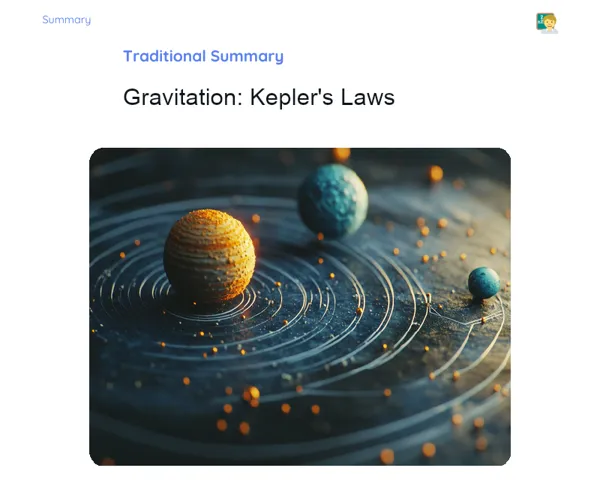Socioemotional Summary Conclusion
Goals
1. ⭐ Understand the concept of wave refraction and identify the situations in which it occurs.
2. 📐 Accurately calculate the angle of refraction using Snell's Law.
3. 🔄 Understand the consequences of refraction in various physical contexts and its impact on daily life.
Contextualization
🔍 Have you ever noticed how a straw appears to be 'broken' when placed in a glass of water? That's wave refraction at work! Refraction is present in many aspects of our daily lives—from how we perceive submerged objects to how cameras capture light. Grasping this concept not only sparks our interest in the world but also has practical applications, like improving our precision in sports or taking stunning photographs. Let’s explore this intriguing subject and see how we can apply this knowledge in a practical and thoughtful manner!
Exercising Your Knowledge
Introduction to Refraction
Refraction is the phenomenon that occurs when a wave, such as light, passes from one medium to another, altering its speed and direction. This happens because each medium has a different refractive index, which affects the wave’s speed. For instance, light moves more slowly in water compared to air.
-
✅ Change in Speed: When light transitions from one medium to another, its speed adjusts according to the refractive index of that medium.
-
✅ Change in Direction: The direction of the wave also alters while crossing different materials, creating some fascinating visual effects.
-
✅ Refractive Index: Every material has a specific refractive index that indicates how much the wave speed decreases in that medium.
Snell's Law
Snell's Law provides a mathematical description of the relationship between the angles of incidence and refraction, as well as the refractive indices of the two media involved. The formula n1 * sin(θ1) = n2 * sin(θ2) is vital for calculating how a wave will refract when passing between two materials.
-
📐 Mathematical Formula: Snell's Law is expressed as n1 * sin(θ1) = n2 * sin(θ2).
-
📐 Refractive Indices: n1 and n2 denote the refractive indices of the respective materials.
-
📐 Angles: θ1 and θ2 represent the angles of incidence and refraction, respectively.
Refractive Index
The refractive index is an indication of how much the speed of a wave, such as light, slows down when it moves from one medium to another. Different materials possess different refractive indices; for example, air is about 1, water is roughly 1.33, and glass is around 1.5.
-
🔍 Definition: The refractive index is the ratio of the speed of light in a vacuum to the speed of light in the medium.
-
🔍 Common Materials: Air (~1), water (~1.33), and glass (~1.5) are examples of materials with specific refractive indices.
-
🔍 Importance: Knowing the refractive indices is crucial for calculating light refraction and predicting how it behaves when moving between different media.
Angles of Incidence and Refraction
The angles of incidence and refraction are essential for understanding the behavior of light when transitioning between different media. The angle of incidence is the angle between the incoming wave and the normal (an imaginary line perpendicular to the surface separating the media), while the angle of refraction is formed between the refracted wave and the normal.
-
📏 Measurement: Utilize protractors to accurately measure the angles of incidence and refraction.
-
📏 Normal: The normal is the line that stands perpendicular to the surface where the wave strikes.
-
📏 Angle of Incidence: The angle formed between the incoming wave and the normal.
-
📏 Angle of Refraction: The angle formed between the refracted wave and the normal.
Key Terms
-
Refraction: The alteration in direction and speed of a wave when moving from one medium to another.
-
Snell's Law: The formula that relates the angles of incidence and refraction to the refractive indices of the media involved.
-
Refractive Index: A measure of how much the speed of a wave decreases when traveling through a material.
-
Angle of Incidence: The angle between the incoming wave and the normal.
-
Angle of Refraction: The angle between the refracted wave and the normal.
For Reflection
-
✨ How can an understanding of refraction help you make better decisions in daily activities like photography or water sports?
-
✨ What emotions did you experience while conducting refraction experiments in groups? How did you manage those feelings?
-
✨ How might your ability to regulate your emotions impact your performance in academic and practical scenarios that involve applying Snell's Law?
Important Conclusions
-
🔍 Refraction is a captivating phenomenon that occurs when a wave changes mediums, altering its speed and direction.
-
📐 Snell's Law is crucial for calculating the angle of refraction, linking the angle of incidence to the refractive indices of the involved media.
-
🔄 Gaining an understanding of refraction allows us to make more accurate observations in various aspects of our daily lives, such as photography, athletics, and even material sciences.
Impacts on Society
Refraction profoundly influences numerous aspects of modern life. For instance, the technology behind spectacles and cameras relies on the principles of refraction. Without this understanding, we wouldn't have the optical innovations that ensure visual corrections and high-quality image capturing. Moreover, refraction plays a vital role in medical technologies like endoscopy, where refracted light helps visualize the inner workings of the body without needing invasive procedures.
Emotions are closely tied to our comprehension of phenomena like refraction. Think of the surprise and wonder experienced when witnessing a rainbow, or the frustration that can accompany trying to understand why a submerged object seems to be located elsewhere. These emotional reactions offer valuable chances to practice recognition and regulation of feelings, enhancing our ability to tackle complex situations.
Dealing with Emotions
To manage emotions while studying refraction, consider employing the RULER method. Start by acknowledging your feelings when facing challenging concepts or conducting experiments. Understand the reasons behind these emotions—perhaps due to difficulties or the happiness of a new discovery. Label these feelings precisely: 'I'm frustrated because I'm struggling with this formula' or 'I'm thrilled because I've accurately measured the angle of refraction.' Share your emotions appropriately, whether by discussing with a classmate or jotting down your thoughts. Lastly, regulate your feelings using techniques such as deep breathing or stepping away for a break, staying calm and focused on learning.
Study Tips
-
📝 Practice the Calculations: Use real-life examples to practice calculating angles of refraction and observing the application of Snell's Law in various contexts.
-
🔬 Conduct Experiments: Set up simple experiments at home using readily available materials such as containers filled with water and torches to observe refraction firsthand.
-
📚 Review and Reflect: Connect theoretical concepts to everyday situations and reflect on how understanding refraction can improve your abilities in areas like photography and sports.



